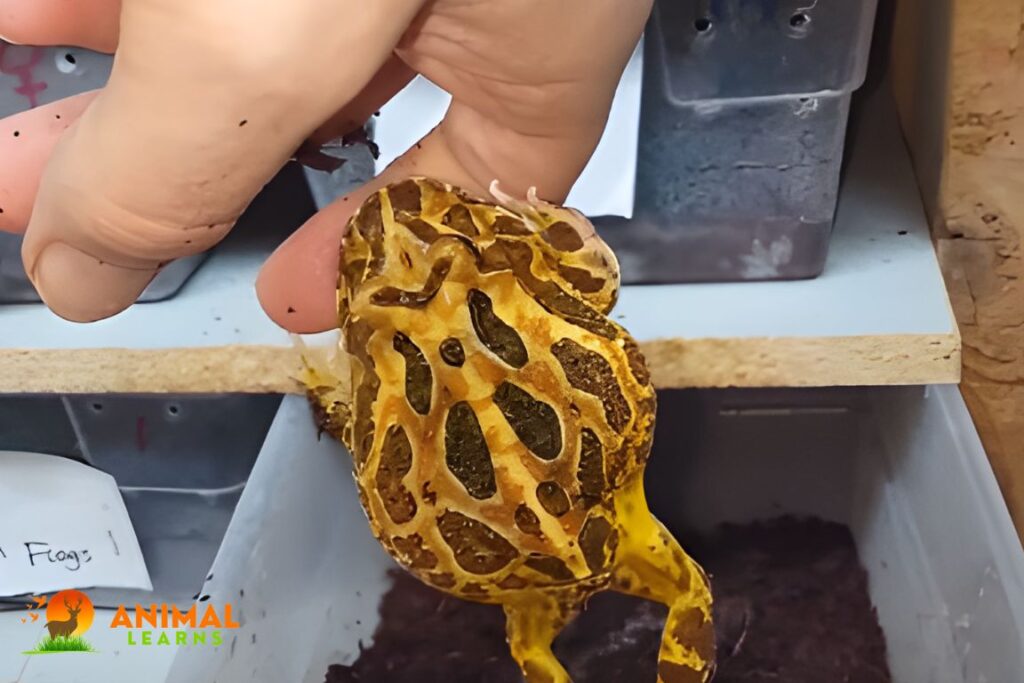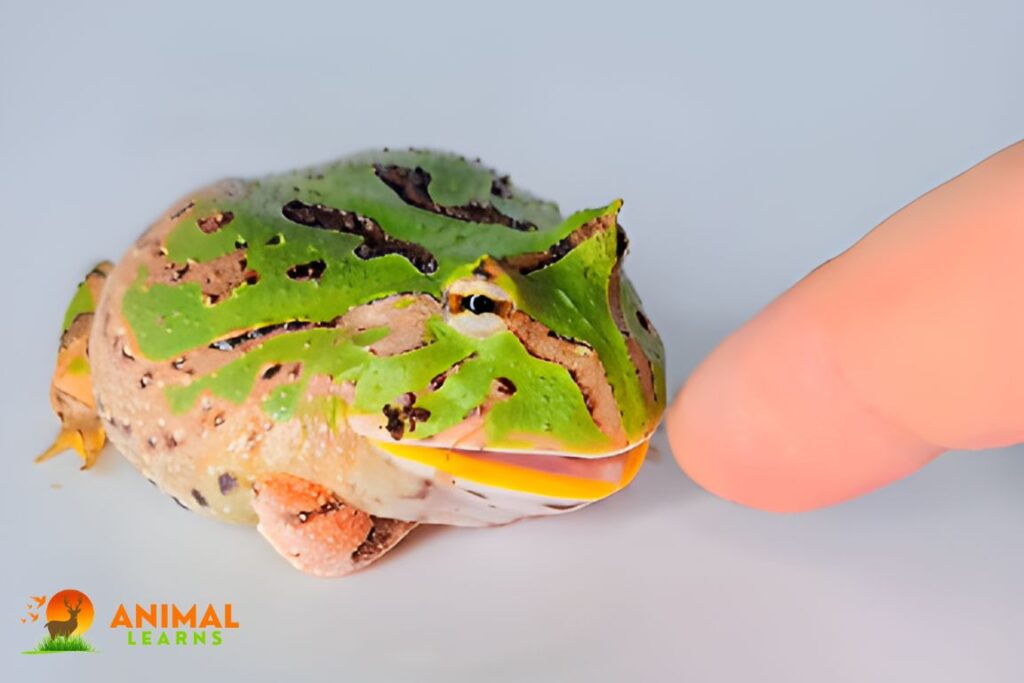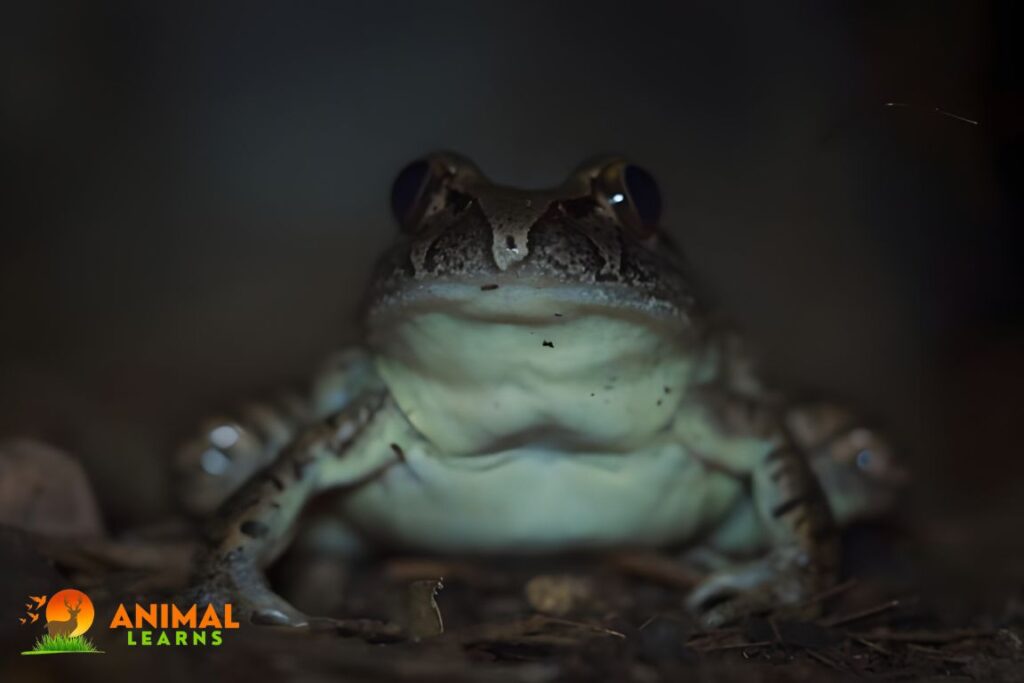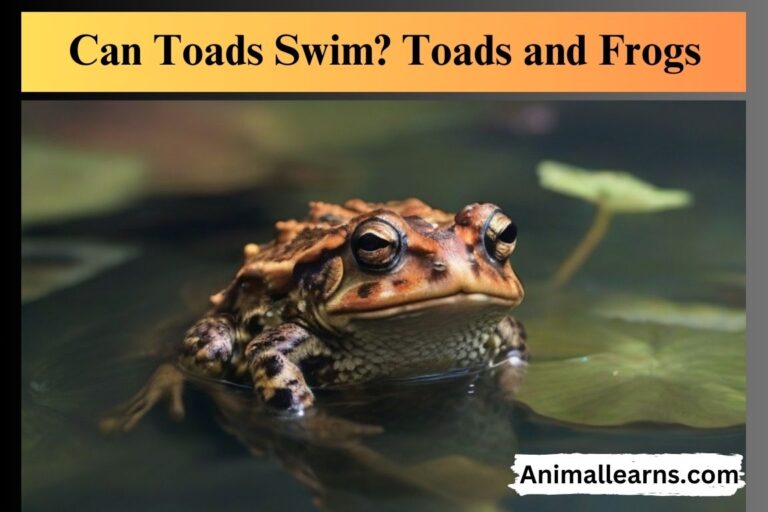Do Frogs Bite? – Animallearns

Do frogs Bite? Because they lack teeth or the typical biting mechanism found in mammals or reptiles, frogs have an unusual way of feeding themselves. Rather, they use a specific technique meant for ingesting prey whole.
Frogs quickly catch insects and other tiny animals with their sticky, retractable tongue. The quick flick of the tongue sticks the meal to its gooey surface, making it easier for the frog to pull back its tongue and swallow the meal whole.
Although biting is not a feeding method used by frogs, certain bigger species may display defensive actions in response to perceived threats. This might entail huffing or making loud, obnoxious noises.
Additionally, some frogs have rough or bumpy skin, which can irritate people somewhat when handled. Frogs are typically non-aggressive toward people and prefer avoidance over conflict, despite their protective mechanisms.
Do Frogs Bite?
Contents
- 1 Do Frogs Bite?
- 2 Why Do Frogs Bite?
- 3 Do Frog Bites Hurt?
- 4 Do Frogs Have Teeth?
- 5 What To Do If A Frog Bites You?
- 6 How Strong Is A Frog’s Bite?
- 7 Are Frogs Dangerous?
- 8 Can Frogs Bite Your Finger Off?
- 9 Are Frog Bites Venomous?
- 10 The Various Bite Forces Of Different Frogs
- 11 Do Pacman Frogs Bite?
- 12 Popular Pet Frogs Known for Biting
- 13 What about Poisonous Frogs?
- 14 Are There Venomous Amphibians?
- 15 FAQs
Despite the widespread belief that frogs are peaceful animals, they occasionally bite, which can cause astonishment, anxiety, and even panic. It’s crucial to remember, though, that frog bites usually cause very little damage and are easily treated.
Frogs are popular pets because of their unusual and intriguing character as well as how simple they are to care for. Even though frogs are ubiquitous across the world, people frequently contact with them.
It’s important to realize that although frogs have mouths, they mostly use them for basic purposes and do not naturally harbor animosity against humans.
Why Do Frogs Bite?
One of two reasons is often responsible for frog bites: fear or hunger. Even the more aggressive frog species—like the Pacman frog—are typically driven by fear or hunger, despite the fact that certain species are more aggressive than others and may bite more quickly.
When they sense danger, frogs will bite to protect themselves. Before biting, frogs often exhibit self-defense-related body language, and they will typically attempt to flee from an irritating object before biting.
Once more, a lot will depend on the species; hostile frogs, such as the Pacman frog, will often merely bite. Other frogs could mistake your hand—or, more frequently, your finger—for what will be their next meal.
Using tongs, refraining from poking your finger at your frog, and just recognizing when your frog is hungry are easy ways to prevent this. It doesn’t take much for frogs to confuse food with fingers because they’re not the most intelligent animals.
Do Frog Bites Hurt?

Although frog bites can cause pain, they usually cause more stunning effects than actual pain. You probably won’t believe how quickly a frog can move, and it’s safe to assume you weren’t prepared for your frog to bite! Blood can be drawn by larger, more formidable species such as horned frogs and African bullfrogs.
It’s reasonable to assume that receiving a bite from almost any animal is not fun, and frogs are no exception. Still, frog bites are very minor compared to other animal bites; you won’t shatter a bone or lose a finger from one.
Do Frogs Have Teeth?
Most frogs do indeed have teeth! Nevertheless, frogs mostly utilize their teeth to restrict their prey before swallowing, in contrast to humans who use them to chew food. Frogs vary greatly in the kind of teeth they have, but the majority have what are essentially teeth.
Given that scientists believe frog species have experienced several tooth gains and losses, frog teeth are really an intriguing indicator of a convoluted and perplexing evolutionary past.
The majority of frogs have maxillary and premaxillary teeth, which are parts of the upper jaw, and this appears to have resulted in a vast variety of tooth kinds.
What To Do If A Frog Bites You?

The first thing you should do if you are bitten by a frog is try not to panic or shake your hand since this might hurt the frog as well as exacerbate any potential injuries. Instead, try to remain composed.
Rather, let the frog separate from you; this will typically occur rather rapidly, and even Pacman frogs will ultimately relent. It’s time to cleanse your hand and the bite site once the frog has detached itself from you.
It’s a good idea to cleanse the area even if there aren’t any blood or visible wounds in case there is a little bite that you can’t notice immediately.
If the frog bite does cause a bleeding wound, you should take extra measures since salmonella can spread more quickly in exposed wounds.
When it comes to frogs, salmonella is by far the most common zoonotic problem and exposed wounds just make it worse.
How Strong Is A Frog’s Bite?
Although it has been reported several times that various frogs have varied bite forces, which frogs top the list for having the strongest bite?
Unexpectedly, a lot of research has been done on this, and we now know that a little horned frog can bite with a force of 30 Newtons, or about 6.5 pounds and that a larger horned frog can bite with a force of 500 Newtons, or an incredible 112 pounds!
In terms of biting force, this means that the several species of horned frogs are the obvious winners. A horned frog bite may cause significant agony, even though 30 Newtons of force may not seem like much. This is because the force is distributed across a limited surface area, your finger.
Researchers discovered that the primary determinant of biting force was head size. Frogs made 30 Newton bites with 45 mm skulls, while frogs made 500 Newton bites with 100 mm skulls.
Thus, a doubling of size results in a biting force that is more than fifteen times greater. This graph shows the association that scientists found between biting force and head size.
Are Frogs Dangerous?

Although frogs are generally not seen to pose a threat to people, there are a few key points to remember. As a defense strategy, some frog species, such as the poison dart frogs found in Central and South America, produce strong poisons via their skin.
The frogs themselves are safe to handle or consume, but these poisons can be damaging if they come into contact with the skin or mucous membranes. Furthermore, illnesses like Salmonella, which people can get through contact with them, can be carried by frogs and other amphibians.
Maintaining proper hygiene is essential to reducing the risk of disease transmission, such as washing your hands thoroughly after touching frogs.
Even though most frogs are not hostile, it is still important to take care while touching them since they might see you as a threat and try to run away. Manipulation may result in harm.
Moreover, catching wild frogs as pets may have negative ecological effects, such as population declines and disruption of nearby ecosystems.
Although typically harmless, handling frogs should be done with caution, especially if they are known to release poisonous skin secretions. Coexistence depends on respecting their environments.
Can Frogs Bite Your Finger Off?
There isn’t a single surviving frog that could bite off a human finger or even seriously hurt them beyond a little cut. Though no current frog actually comes close, the now-extinct Beelzebufo ampinga was huge enough that they could have succeeded (pun intended).
It’s easy to let our imaginations run wild with all this discussion about biting force, but it’s quite improbable that a frog will actually cause any harm, least of all severing a finger!
Are Frog Bites Venomous?
Although the strength of the bites might not be alarming, if frogs could pump poison into the wound, then things would undoubtedly change.
Fortunately, though, this is quite rare, with just two frogs known to be venomous:
- The corythomantis greeningi, or Greening’s frog
- Aparasphenodon brunoi, sometimes known as Bruno’s casque-headed frog
It’s also important to define the distinction between toxic and venomous species. A frog would have to inject its poison by a bite or stinger and take the initiative in order to be classified as poisonous.
On the other hand, poisonous frogs only release their venom when they are bitten or when the predator takes the offensive.
The Various Bite Forces Of Different Frogs
Exploring the realm of amphibian biology, one intriguing aspect is the diversity in bite forces among different frog species, shedding light on the question “Do frogs bite?” and revealing the varying degrees of strength in their jaw mechanisms.
Naturally, frog bites differ significantly across species. There are few exceptions to the general rule that a frog’s biting strength increases with size. The biting force, expressed in Newtons (N), is a measure of a bite’s potency.
A meter wrapped in leather is inserted between an animal’s jaws to measure this. The apparatus registers the pressure that the bite has attained. The bites from a sample of the same species are then averaged by the researchers.
The bite force is closely correlated with head and jaw size, even though it is recorded as a separate statistic.
In fact, they are so inextricably related that “scaling” tests are frequently conducted.
Here, by varying the head width, researchers may compute the biting force of bigger individuals within the same species. Because they are just not worth measuring, the majority of frogs have not had their bite forces tested.
Nonetheless, a few noteworthy investigations yielded the following outcomes:
| Frog Species | Bite Force in Newtons |
| Small Horned Frogs | 30 Newtons |
| Large Horned Frogs | 500 Newtons |
| Beelzebufo (extinct) | 2200 Newtons |
Do Pacman Frogs Bite?

Popular pet frogs that are known to bite are called Pacman Frogs. They can even devour tiny lizards, birds, and bats, therefore their size and availability of prey may be the cause of this.
They could bite for a few more reasons.
- When Pacman frogs perceive a threat or a very hostile environment, they may bite in self-defense. These bites can be painful because of their size, but they seldom result in significant harm.
- Additionally, Pacman frogs have the propensity to bite their owners if they think of their fingers as food.
Pacman frogs, in contrast to lesser frogs, have the ability to defend themselves by using their teeth.
They also have some of the biggest and sharpest teeth of any species of frog, which is probably a combination of the two. With a biting force of 30 newtons, they are likewise quite strong. That is around 3 kilograms, or 6.6 lbs, which is a significant amount for their tiny frames (CTNF).
Popular Pet Frogs Known for Biting
Yes, that is the response. While most frogs don’t like to bite, there are certain species that do love it. Among these are Pacman frogs, Budgett’s frogs, and African Bullfrogs.
Pacman frogs have no problem biting anything that looks dangerous to them. For their size, they have a powerful bite and a powerful jaw.
Those who own Pacman Frogs frequently inquire about the ideal way to feed them. It’s an easy procedure. All you have to do to feed them is use a tong.
The budgetta frogs take pleasure in taking on predators and other possible enemies. They will try to terrify you by making noise and seeming large when they think you are a threat.
It’s time to keep your distance if you see any of the indicators left by a Budgett’s Frog in your area. Should you not do so, you could get bitten.
Popular pets within the herptile society are African Bullfrogs. But even they have a history of biting. They bite and hold prey using their large jaws and fangs.
What about Poisonous Frogs?

Native hunters used to construct poison darts out of poison dart frogs since they are so lethal. Why are these stunning creatures so threatening?
A hunter moves between the trees in the steamy Colombian rainforest in quest of food. The hunter steadies his blowgun, darts in place, and prepares to shoot after seeing a monkey. All you need is one dart.
The dart is described as “sure death to any man or animal it strikes” in an eyewitness testimony from 1825. It is lethal to both people and animals due to its toxin.
venom darts, which are produced from the venom of tiny yellow frogs that are just a few millimeters in length, were often employed by hunters from the Embera tribe of Columbia to kill birds, monkeys, and other small animals.
Golden Toxin Frogs contain enough toxins in them to kill ten adult men, making them some of the deadliest creatures on the planet. Even though they are tiny—the biggest measures little more than 6 cm, and some are as short as 1.5 cm—they may nevertheless be quite hazardous. Why and how did they become so toxic?
While it is true that a wide variety of animal species create poisons, the majority do not pose a threat to people. An animal must expel poisons in order to be toxic. Because those toxins are dangerous when consumed or absorbed, they are classified as poisons.
For example, deadly snakes like the rattlesnake are venomous rather than toxic. A toxic material called venom is administered by fangs, stingers, etc.
Are There Venomous Amphibians?
Tongues are secreted by most frogs, salamanders, and newts. Swallowing them is risky since they utilize these toxins to protect themselves from predators.
But according to the authors of a 2015 study, certain frogs could possibly be poisonous if further research is done on them.
The authors also propose that further research be done to find out whether other frogs with spines in their heads are poisonous. Among the species examined are Aparasphenodon brunoi and Corythomantis greening.
Because of this, even though they are rare, there could be more poisonous amphibians that have not yet been properly recognized.
In summary, the majority of frogs are classified as “poisonous” because they are at least somewhat toxic. With the exception of a few Phyllobates poison-dart frogs, which are potentially fatal, almost all of them are safe for people to handle.
Furthermore, certain frogs are poisonous, but as far as we are aware, they don’t bite or use their teeth to deliver the toxins!
Contrary to common misconceptions, the reality is that while frogs may exhibit defensive behaviors, the likelihood of experiencing a harmful bite is minimal.
The question “do frogs bite?” underscores the importance of understanding their natural behaviors and the rarity of such occurrences in reality.
FAQs
Do all frogs bite?
No, not all frogs bite. While some larger species may exhibit defensive behaviors, most frogs are not aggressive toward humans.
Are frog bites harmful to humans?
Generally, frog bites are harmless and cause minimal harm. Treatment is usually easy, and the risk of injury is low.
Do frogs have teeth?
No, frogs are not toothed animals. Rather, they catch and swallow prey whole using a unique feeding mechanism that includes a sticky, retractable tongue.
Can frog bites be poisonous?
Frog bites are usually not toxic, however, certain species do release poisons through their skin. With certain poisonous species, nevertheless, caution is required.
What should I do if a frog bites me?
If you get bitten, wash the area with water and mild soap. Even while frog bites are usually not harmful, you should still get medical help if you have any strange symptoms or if the species that bit you is known to be hazardous.












